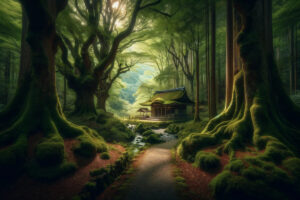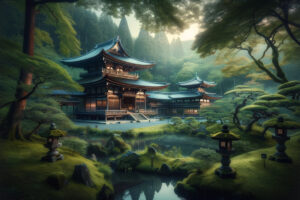
Get ready to immerse yourself in the serene beauty of the best gardens in Kyoto. From the enchanting Zen rock gardens to vibrant cherry blossom havens, this listicle is your gateway to discovering the top green gems in Kyoto.
Explore a blend of traditional Japanese landscaping and modern horticultural marvels that will leave you awe-inspired. Delve into our curated selection showcasing the most picturesque and tranquil spots that Kyoto has to offer, each with its unique charm waiting to be uncovered.
Scroll down for reviews of our top picks!
- Key Takeaways
- 10 Best Gardens In Kyoto
- 1. Kinkaku-ji’s Golden Pavilion Garden
- 2. Ryoan-ji’s Rock Garden
- 3. Tenryu-ji’s Sogen Pond Garden
- 4. Saiho-ji’s Moss Garden
- 5. Nanzen-ji’s Leaping Tiger Garden
- 6. Ginkaku-ji’s Silver Pavilion Moss Garden
- 7. Tofuku-ji’s Zen Garden
- 8. Shisen-do’s Hermit’s Garden
- 9. Kennin-ji’s Twin Dragons Garden
- 10. Murin-an’s Meiji Era Garden
- Summary
- Frequently Asked Questions
- What makes Kinkaku-ji’s Golden Pavilion Garden a must-visit in Kyoto?
- Is Ryoan-ji’s Rock Garden suitable for meditation and contemplation?
- Why should visitors explore Saiho-ji’s Moss Garden in Kyoto?
- What sets Nanzen-ji’s Leaping Tiger Garden apart from other gardens in Kyoto?
- How does Tofuku-ji’s Zen Garden embody the principles of Zen philosophy?
Key Takeaways
- Visit Kinkaku-ji’s Golden Pavilion Garden to admire the stunning golden temple reflected in the serene pond, offering a glimpse of traditional Japanese architecture amidst nature.
- Experience tranquility at Ryoan-ji’s Rock Garden, where simplicity and minimalism create a peaceful atmosphere for contemplation and meditation.
- Explore the harmonious blend of water and mountains at Tenryu-ji’s Sogen Pond Garden, showcasing the essence of Japanese landscape design and Zen philosophy.
- Immerse yourself in the serene beauty of Saiho-ji’s Moss Garden, known for its lush green moss covering the ground and creating a serene, mystical ambiance.
- Witness the dynamic energy of nature at Nanzen-ji’s Leaping Tiger Garden, where carefully placed rocks symbolize a tiger ascending a waterfall, capturing movement in a still landscape.
- Discover the understated elegance of Ginkaku-ji’s Silver Pavilion Moss Garden, featuring meticulously raked gravel patterns and moss-covered hills that evoke a sense of tranquility and simplicity.
10 Best Gardens In Kyoto
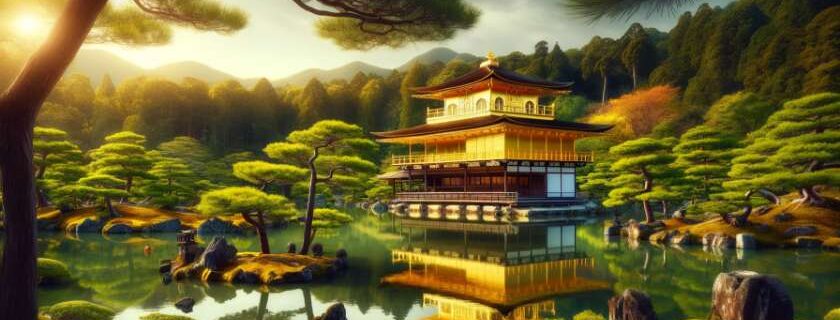
1. Kinkaku-ji’s Golden Pavilion Garden
Kinkaku-ji’s Golden Pavilion Garden is renowned for its iconic golden pavilion set amidst meticulously landscaped gardens, creating a serene and picturesque setting. The reflective pond surrounding the pavilion not only adds to its beauty but also symbolizes purity and calmness in line with Zen Buddhist principles [1].
Visitors to this garden are treated to stunning views of the surrounding nature, offering a unique experience that blends natural beauty with architectural marvels. The temple complex provides an oasis of tranquility within Kyoto’s bustling city, making it a must-visit destination for those seeking both aesthetic pleasure and spiritual rejuvenation.
The landscape design of Kinkaku-ji incorporates elements like cherry blossoms and fall colors, enhancing the visual appeal throughout different seasons. This harmonious blend of man-made structures with carefully curated landscapes showcases the intricate balance between human creativity and nature’s splendor.
2. Ryoan-ji’s Rock Garden
Ryoan-ji’s Rock Garden is renowned for its design, featuring 15 carefully placed rocks on a bed of white gravel. This iconic dry landscape garden is not merely an arrangement of stones but a masterpiece crafted to evoke deep contemplation and meditation.
The deliberate placement of these rocks amidst the raked white gravel creates a scene that encourages introspection and mindfulness. Visitors often find themselves drawn into a state of tranquility as they ponder the simplicity and symbolism behind this serene setting.
The concept behind Ryoan-ji’s Rock Garden reflects Japanese aesthetics, emphasizing minimalism and the beauty found in simplicity. The absence of extravagant features or lush greenery allows individuals to appreciate the raw elegance of nature in its most unembellished form.
This unique blend of rock elements with meticulously maintained white gravel symbolizes harmony between man-made structures and natural landscapes, offering visitors a space for quiet reflection amid Kyoto’s bustling city life.
3. Tenryu-ji’s Sogen Pond Garden
One of Kyoto’s oldest Zen temples, Tenryu-ji boasts a serene pond garden that dates back centuries. The design of the garden is meticulously crafted, featuring a harmonious blend of greenery and colorful flowers.
Visitors are treated to stunning views of the Arashiyama mountains while strolling through this picturesque landscape. The tranquil ambiance created by the suizen (spring) season enhances the beauty of the pond, making it a must-visit spot for nature enthusiasts in Kyoto.
The Sogen Pond Garden at Tenryu-ji offers a peaceful retreat from the hustle and bustle of city life, allowing guests to immerse themselves in the tranquility of nature. This oasis provides an ideal setting for meditation or simply enjoying a moment of serenity amidst lush surroundings.
With its rich history and captivating beauty, Tenryu-ji’s Sogen Pond Garden stands as a testament to Kyoto’s cultural heritage and reverence for natural landscapes.
4. Saiho-ji’s Moss Garden
Saiho-ji, also known as the “Kokedera” or Moss Temple, is a favorite among garden enthusiasts for its captivating moss-covered landscape. With over 120 varieties of moss meticulously arranged, this garden offers a serene and magical ambiance that is truly unique.
Visitors to Saiho-ji must plan ahead and secure reservations in advance to explore this exceptional garden fully. The controlled growth of different types of moss creates an otherworldly experience that transports visitors into a world of tranquility and beauty.
The intricate design of the garden showcases how plants like moss can be transformed into an art form, demonstrating nature’s ability to create breathtaking landscapes with minimalist elements. Each variety of moss contributes to the overall aesthetic appeal, making every corner of Saiho-ji a sight to behold.
For those seeking a one-of-a-kind botanical adventure filled with lush greenery and peaceful surroundings, Saiho-ji’s Moss Garden stands out as a must-visit destination in Kyoto for an unforgettable experience amidst nature’s wonders.
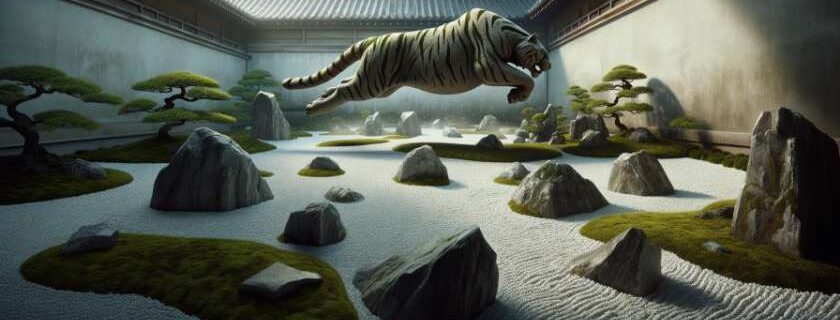
5. Nanzen-ji’s Leaping Tiger Garden
Nanzen-ji’s Leaping Tiger Garden is a Zen rock garden that artfully incorporates large rocks to symbolize the majestic leap of a tiger, exuding a sense of power and vitality through its design. This representation aims to mirror the dynamic energy found in nature, offering visitors a serene retreat from Kyoto’s urban clamor.
The arrangement of these rocks within the garden is meticulously crafted to evoke feelings of strength and movement, encouraging contemplation and reflection on the forces at play in the natural world. The simplicity of this landscape fosters a tranquil ambiance perfect for meditation or quiet introspection amidst Japan’s historical capital.
Visitors can marvel at how each element within this garden harmonizes with one another, creating an immersive experience that transports them into a realm where nature reigns supreme. As you stroll through Nanzen-ji’s Leaping Tiger Garden, allow yourself to be enveloped by the tranquility it radiates, offering solace and peace amid Kyoto’s bustling streets.
Immerse yourself fully in this sanctuary where every stone tells a story; let your mind wander as you absorb the essence of Zen philosophy woven into every aspect of this exquisite space.
6. Ginkaku-ji’s Silver Pavilion Moss Garden
at Ginkaku-ji, a UNESCO World Heritage Site, the iconic silver pavilion and meticulously tended moss garden stand out as key attractions. The well-maintained moss beds along tranquil walking paths offer visitors a serene experience amid nature’s beauty.
The moss garden at Ginkaku-ji provides a unique visual treat with its lush greenery contrasting against the shimmering silver sand. This harmonious blend creates an ambiance of tranquility that is perfect for contemplation and relaxation.
Visitors are treated to breathtaking views of the Higashiyama Mountains from various vantage points within the garden. These stunning vistas add to the overall charm of Ginkaku-ji and make it a must-visit destination in Kyoto for nature lovers and those seeking peaceful surroundings.
Ginkaku-ji’s Silver Pavilion Moss Garden encapsulates Japanese aesthetics, offering an immersive experience that showcases the delicate balance between man-made structures like the pavilion and natural elements such as moss and sand. This fusion of architecture and landscape design exemplifies Japan’s profound appreciation for harmony in all aspects of life.
7. Tofuku-ji’s Zen Garden
Tofuku-ji’s Zen Garden in Kyoto is renowned for its picturesque Tsutenkyo Bridge, stretching above a canopy of vivid maple trees. The garden boasts meticulously crafted Zen rock gardens and well-manicured shrubs that together create a serene and balanced atmosphere perfect for contemplation.
Visiting this zen temple during the autumn season offers visitors an unparalleled experience with stunning foliage displays that paint the landscape in vibrant hues of red, orange, and gold. The unique blend of nature and artistry at Tofuku-ji makes it a must-visit destination for those seeking tranquility amidst breathtaking surroundings.
The garden features elements typical of traditional Japanese stroll gardens, reflecting the principles of Zen Buddhism through its design and layout. The presence of tea houses within the temple grounds allows visitors to immerse themselves fully in the peaceful ambiance while enjoying a cup of matcha tea.
For travelers looking to explore authentic zen temples in Kyoto, Tofuku-ji stands out as an exemplary representation of Japanese zen style gardens. Its meticulous attention to detail and harmonious composition make it a standout attraction for anyone interested in experiencing the essence of Zen philosophy amidst nature’s beauty.
8. Shisen-do’s Hermit’s Garden
Shisen-do’s Hermit’s Garden is a tranquil retreat crafted by a poet-monk in the 17th century. This serene sanctuary boasts a mesmerizing moss garden, enchanting bamboo grove, and winding stone paths that invite visitors to wander contemplatively.
The moss garden at Shisen-do exudes an ancient charm, with its velvety green carpet covering the ground and creating a soothing atmosphere. The bamboo grove adds an element of Zen-like simplicity, swaying gently in the breeze and providing shade for quiet reflection.
Visitors can immerse themselves in a peaceful and introspective experience as they meander along the stone paths that wind through this picturesque landscape. Each step offers a moment of tranquility, allowing guests to connect with nature and find solace away from the hustle and bustle of everyday life.
With its rich history and carefully curated design elements, Shisen-do’s Hermit’s Garden stands as a testament to the beauty of simplicity and the power of nature to inspire inner peace. A visit to this hidden gem in Kyoto promises not just sightseeing but also an opportunity for spiritual rejuvenation amidst stunning natural surroundings.
9. Kennin-ji’s Twin Dragons Garden
Kennin-ji stands as the oldest Zen temple in Kyoto, boasting a mesmerizing dragon-themed garden that captivates visitors with its cultural significance and beauty. Inside the main hall, two striking dragon paintings grace the ceiling, symbolizing power and protection.
The meticulously landscaped gardens surrounding Kennin-ji Temple serve as an extension of its tranquil ambiance, offering a peaceful retreat from the bustling city life of Kyoto. The harmonious blend of architectural elements and nature creates an atmosphere conducive to contemplation and meditation.
Visitors can immerse themselves in the rich history and symbolism embodied by the Twin Dragons Garden at Kennin-ji. This serene oasis provides a glimpse into Japan’s spiritual heritage while showcasing exquisite craftsmanship through its artful design.
Exploring this iconic garden allows guests to appreciate not only the aesthetic appeal but also the profound cultural roots embedded within every detail. From mythical creatures to carefully curated landscapes, Kennin-ji’s Twin Dragons Garden offers a holistic experience that resonates with both locals and tourists alike.
10. Murin-an’s Meiji Era Garden
Murin-an’s Meiji Era Garden was meticulously designed by Ogawa Jihei, a highly respected landscape architect known for his exceptional work in traditional Japanese garden design. This historic garden beautifully blends elements of traditional Japanese landscaping with subtle Western influences, creating a unique and harmonious aesthetic.
Featuring a large pond as its centerpiece, the garden offers visitors a serene atmosphere to enjoy the carefully pruned trees and lush greenery that surround it. The presence of a charming teahouse adds to the authenticity of the experience, allowing guests to immerse themselves fully in the tranquility and beauty of this cultural gem.
Ogawa Jihei’s attention to detail is evident throughout Murin-an’s Meiji Era Garden, showcasing his mastery in creating landscapes that evoke both peace and contemplation. Whether you are strolling along the pathways or admiring the reflections on the water surface, every corner reveals a new perspective on nature’s artistry at its finest.
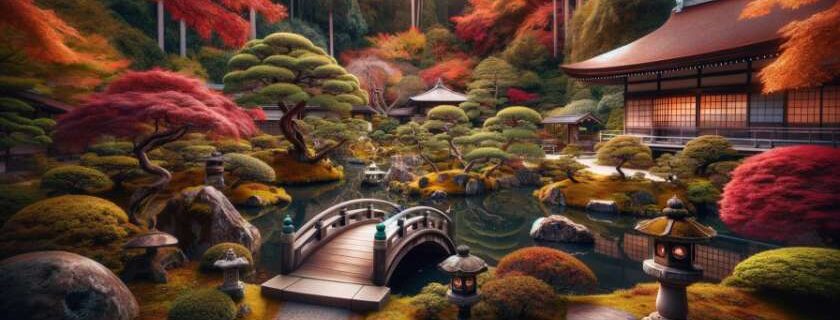
Summary
You’ve now explored the best gardens in Kyoto, each offering a unique blend of tranquility and beauty. From the serene simplicity of Ryoan-ji’s Rock Garden to the lush greenery of Saiho-ji’s Moss Garden, Kyoto’s gardens are a testament to Japan’s deep-rooted appreciation for nature. As you envision strolling through these picturesque landscapes, remember that each stone, plant, and pond has a story to tell—a story of tradition, harmony, and mindfulness.
So, why not plan your next adventure to Kyoto and immerse yourself in the enchanting world of these breathtaking gardens? Let their peaceful allure inspire you to find moments of serenity and connection with nature in your own life. The beauty of Kyoto’s gardens awaits your presence—go forth and let their timeless charm captivate your soul.
Frequently Asked Questions
What makes Kinkaku-ji’s Golden Pavilion Garden a must-visit in Kyoto?
Kinkaku-ji’s Golden Pavilion Garden is renowned for its stunning golden pavilion set against the lush greenery and serene pond, creating a mesmerizing reflection. The harmonious blend of architecture and nature offers a tranquil escape from the bustling city life.
Is Ryoan-ji’s Rock Garden suitable for meditation and contemplation?
Yes, Ryoan-ji’s Rock Garden is an ideal spot for meditation and contemplation. The simplicity of the rock formations amidst raked white gravel symbolizes harmony and encourages visitors to reflect on the beauty of minimalism and tranquility.
Why should visitors explore Saiho-ji’s Moss Garden in Kyoto?
Saiho-ji’s Moss Garden, also known as “Koke-dera,” captivates with its lush green moss covering every surface like a soft carpet. This garden provides a unique immersive experience where visitors can appreciate the serenity of nature while walking along moss-covered paths.
What sets Nanzen-ji’s Leaping Tiger Garden apart from other gardens in Kyoto?
Nanzen-ji’s Leaping Tiger Garden stands out for its dynamic landscape design that evokes movement and energy through carefully placed rocks resembling leaping tigers. The garden invites visitors to admire not just static beauty but also the essence of motion captured within nature.
How does Tofuku-ji’s Zen Garden embody the principles of Zen philosophy?
Tofuku-ji’s Zen Garden embodies simplicity, balance, and mindfulness through its minimalist design featuring meticulously raked gravel patterns around carefully placed rocks. Visitors can experience a sense of peace and clarity by observing this garden that reflects Zen ideals through natural elements.

